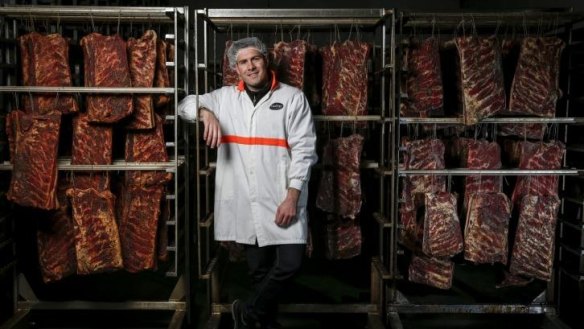Pork belly demand puts it a cut above the rest

Melbourne's insatiable appetite for pork belly has seen its price rise, the consumption of foreign sourced bacon skyrocket and local smallgoods manufacturers having to give up traditional preserved meats such as pancetta.
Up until recent years pork belly was a secondary cut that was ground into sausages. Now pork belly is so highly sought after by restaurants that some smallgoods manufacturers have been left high and dry and unable to source the fatty underside of porkers to make their goods.
Carmine Ventura is a third generation Italian smallgoods manufacturer. "For the first time since my grandfather started this business 55 years ago we can't make rolled pancetta, " says Ventura, general manager of Casalingo, smallgoods manufacturer in Clayton South.
Pancetta is a cured pork product that is used extensively in cooking, particularly in Italian restaurants. Ventura says the wholesale price of pork belly has gone up at least $2 (a kilogram) in the last year. "Pork belly is getting harder and harder to buy," he says. "Our growing Asian community uses a lot of belly and that pushes the price up."
Casalingo uses locally grown pork bellies for its pancetta and has been forced to delete its popular range of rolled pancetta but is still making traditional flat pancetta. It is absorbing the price increase.
"Almost every restaurant in Australia has pork belly on the menu," says upmarket butcher Peter Bouchier from his wholesale butchery in Moorabin. He says five years ago quality pork belly was selling for under $12 a kilogram retail. Today the supermarket price is $17-$18 a kilogram, with some independent butchers charging over $30 a kilogram.
"We saw the mass take-up of the pork belly after it featured on shows like MasterChef five years ago," he says. "Now pork belly is expensive and hard to get. Even local cafes are serving it up.
"It is impossible to get enough pork belly to meet demand," he says.
Mitch Edwards, marketing manager from Australian Pork Ltd, points the finger of pork belly's rise from butcher shop offcut to culinary superstar at Sydney chef Peter Gilmore and Adelaide chef Cheong Liew. "Before them, and we're talking globally, pork belly was mainly confined to Asian chefs," he says. "Those Australian chefs pushed it out to the rest of the world."
He says that Australian demand for fresh pork now outstrips supply. This lack of Australian pork has seen local pork and ham manufacturers increasingly rely on imported pork to meet demand. "Seventy per cent of bacon, ham and smallgoods in Australia is produced from cheap, subsidised imported pork," Edwards says.
Edwards stresses that all imported pork must be cooked during manufacture and that all fresh pork in the market is Australian grown.
The high belly price is good for pig farmers such as Jason and Belinda Hogan. They raise their herd of free-range pigs on pasture at McIvor Farms at Tooborac, near Heathcote. "We have a premium product and we charge a premium," says Belinda.
"But we have high labour and high feed costs. We could never supply enough belly to meet demand," she says.
They sell belly for $25 a kilogram and supply the top restaurants in central Victoria including Annie Smither's Du Fermier and Masons of Bendigo. "At that price we encourage chefs to serve the belly as an entree and use the cheaper cuts such as shoulder for the main-course dishes," she says.
Bouchier predicts that cheaper cuts such as smoked pork hock and pork shoulder are the next pork cuts to see a price hike. "You watch," he says. "Just a few years ago I couldn't sell pork shoulder. Now, with the American trend of slow cooking in Texan style barbecues to make pulled pork, the demand is going up and up."
Restaurant reviews, news and the hottest openings served to your inbox.
Sign up- More:
- Restaurant news
